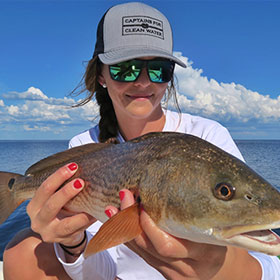Jigging for Beginners: 5 Tips for Gear, Tackle, and Technique
By Alycia Downs
Jul 02, 2019
Jigging for beginners. Shore jigging is a unique style of fishing that requires specialized gear, tackle, and techniques. Learn quick tips here!
Shore jigging is a common style of fishing that involves casting heavy lures, called jigs, from shore into varying depths of water. The retrieve technique is also referred to as “jigging,” but there isn’t one right or wrong way to execute it properly. If you’re attempting jigging for beginners, here are a few quick tips on gear, tackle, and technique.
1. Lightweight, Powerful Rod
If you plan on all-day jigging, you’ll want a rod that is lightweight, yet has flexibility for working heavy jigs and enough backbone to haul large, strong fish. Go for a moderate fast to fast action rod tip, heavy to extra heavy power, and 5 to 7-feet in length. Many brands offer rods specially designed for jigging for beginners.
2. High-gear Reels
Look for reel models labeled with “HG” which indicates high speed gear. Reels with a higher gear ratio retrieve more line per rotation of the handle which gives you more precise control over the movement of the jig and less fatigue when casting and reeling for long periods. When it comes to shore jigging for beginners, this tip will have you looking like a pro.
3. 40 to 80-pound Test Leader
Use a heavy leader that’s abrasion-resistant against rocks and structure and also strong enough to withstand hard runs and deep dives of powerful game fish.
4. Metal Jigs
The shapes, colors, and styles of jigs are endless, but the type used for shore jigging are typically flat, weighted, and intended to be used with a single hook.
5. Varying Retrieve Techniques
The technique often depends on the type of lure you’re using, but will generally entail some variation of jerky up and down movements. Quick jerk, let it fall. Steady twitches. Fast reeling retrieve with erratic twitches. You can’t predict for certain what type of movement will convince the fish to bite that day so try different methods until you find what works.
Jigging for beginners requires versatility. Be willing to learn, adjust, and adapt until you find the right gear, tackle, and techniques that work for your area. Even when shore jigging for beginners, you’ll still need to have the proper fishing license. Search online by state or visit your local sporting goods retailer to purchase one in person. And check out more beginner fishing tips such as how to set the hook or how to land a fish. Enjoy!









